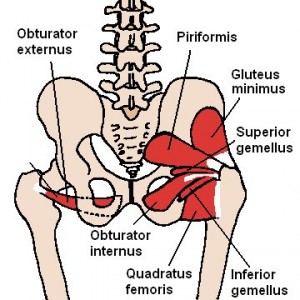The piriformis muscle is a very strong hip muscle, one of the core muscles of the body.
The piriformis is a flat, pear-shaped muscle that is located beneath the gluteal musculature. There are two piriformis muscles that sit behind the hip sockets, extending from the upper, outer corner of each femur (thighbone) to the sacrum. The piriformis muscles are joined by a band of connective tissue, or fascia, that stretches across the sacrum just above the tailbone.The primary function of the piriformis is the external rotation of the hip, and is part of the hip rotator cuff — a number of small, deep muscles that rotate the leg outward at the hip. It also helps with abduction (moving away from the midline of your body) and extension (lifting your leg behind you). The piriformis laterally rotates the femur with hip extension and abducts the femur with hip flexion.
The piriformis also plays an important role in stabilising your core.
Limitations in the piriformis can translate into pain and strain in your lower back. When the piriformis gets tight, it pinches the sciatic nerve and causes a burning pain at various points along the nerve’s path, which runs from the buttock all the way down to your foot.
The Role of the Piriformis in the Golf Swing
The hips play a crucial role in the golf swing, and the piriformis is one of the strongest muscles in the hip complex.
Having the control and flexibility to move your hips without moving the rest of your pelvis and torso is crucial for good hip mechanics and a good golf swing, as is the ability to open your lead hip independently of the rest of your body. Sufficient strength and flexibility in the piriformis helps you to perform these movements correctly and efficiently, and it takes stress off your hip joint to help prevent injury and to keep you rotating through the ball.
As well as helping you to rotate your pelvis efficiently, especially in the downswing, through the external rotation of the hip joint, the piriformis helps to create lateral stability within the hip for consistency and efficient power transfer.
The piriformis provides stability to your sacrum, the triangular bone that connects the back of your pelvis to your spine, by regulating movement and stability in the sacroiliac (SI) joints. The SI joints have to be loose enough to allow your pelvic bones to move with your legs when you turn in the backswing, yet stable enough to support your spine during the downswing.
For most golfers, the piriformis (and the other muscles that attach from the hips to the pelvis) are weak, and thus their pelvis has a tendency to slide too far toward the target during the downswing, which prevents their hips from rotating properly. Thus the golfer is unable to “clear their hips” and create room for their arms to move through, often causing a blocked or a sliced shot.
When muscles in the hip complex, including the piriformis, are strong and working properly, the golfer is able to rotate efficiently around the lead hip, and to thrust the lead leg into the ground, in the downswing and through impact, which enables the efficient transfer of energy generated in the legs through the core and into the golf club, making it easier to hit more powerful and accurate golf shots.
A strong hip complex also helps the golfer to maintain their spine angle through the golf swing. This is especially true with longer clubs, where the rotational forces that must be absorbed by the body are significant. These high loads can easily pull a weak hip complex out of position during the downswing, resulting in a loss of spinal posture before impact.
Piriformis Exercises
Mobility exercises:
Pelvic Disassociation Exercise
If you have any questions or comments about this or other articles on Golf Loopy, please send us an email.
You May Also Like…
Overview of a Great Golf Swing, which summarises the correct movements in a great golf swing.
Golf Swing 201 – Takeaway: The Perfect Golf Swing Takeaway.
Drill 202 – Takeaway: Pelvic Disassociation.
Golf Swing Drill 203 – Takeaway: Core Disassociation.
Golf Anatomy and Kinesiology, a collection of articles describing the roles of the muscles involved in the golf swing.
Core muscles, which describes the muscles that run the length of your trunk and torso.
Oblique muscles, which describes in more detail your side abdominals, which help you to bend from the side or twist your torso, and their role in the golf swing.
Psoas major muscle, which describes the hip flexors, and their role in maintaining your spine angle in the downswing.





